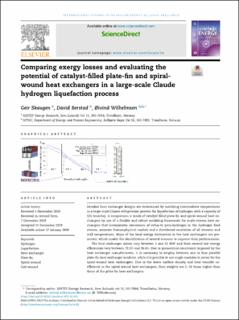| dc.contributor.author | Skaugen, Geir | |
| dc.contributor.author | Berstad, David Olsson | |
| dc.contributor.author | Wilhelmsen, Øivind | |
| dc.date.accessioned | 2020-04-17T10:11:24Z | |
| dc.date.available | 2020-04-17T10:11:24Z | |
| dc.date.created | 2019-12-12T10:07:56Z | |
| dc.date.issued | 2020 | |
| dc.identifier.citation | International journal of hydrogen energy. 2020, . | en_US |
| dc.identifier.issn | 0360-3199 | |
| dc.identifier.uri | https://hdl.handle.net/11250/2651495 | |
| dc.description.abstract | Detailed heat exchanger designs are determined by matching intermediate temperatures in a large-scale Claude refrigeration process for liquefaction of hydrogen with a capacity of 125 tons/day. A comparison is made of catalyst filled plate-fin and spiral-wound heat exchangers by use of a flexible and robust modeling framework for multi-stream heat exchangers that incorporates conversion of ortho-to para-hydrogen in the hydrogen feed stream, accurate thermophysical models and a distributed resolution of all streams and wall temperatures. Maps of the local exergy destruction in the heat exchangers are presented, which enable the identification of several avenues to improve their performances.
The heat exchanger duties vary between 1 and 31 MW and their second law energy efficiencies vary between 72.3% and 96.6%. Due to geometrical constraints imposed by the heat exchanger manufacturers, it is necessary to employ between one to four parallel plate-fin heat exchanger modules, while it is possible to use single modules in series for the spiral-wound heat exchangers. Due to the lower surface density and heat transfer coefficients in the spiral-wound heat exchangers, their weights are 2–14 times higher than those of the plate-fin heat exchangers.
In the first heat exchanger, hydrogen feed gas is cooled from ambient temperature to about 120 K by use of a single mixed refrigerant cycle. Here, most of the exergy destruction occurs when the high-pressure mixed refrigerant enters the single-phase regime. A dual mixed refrigerant or a cascade process holds the potential to remove a large part of this exergy destruction and improve the efficiency. In many of the heat exchangers, uneven local exergy destruction reveals a potential for further optimization of geometrical parameters, in combination with process parameters and constraints.
The framework presented makes it possible to compare different sources of exergy destruction on equal terms and enables a qualified specification on the maximum allowed pressure drops in the streams. The mole fraction of para-hydrogen is significantly closer to the equilibrium composition through the entire process for the spiral-wound heat exchangers due to the longer residence time. This reduces the exergy destruction from the conversion of ortho-hydrogen and results in a higher outlet mole fraction of para-hydrogen from the process.
Because of the higher surface densities of the plate-fin heat exchangers, they are the preferred technology for hydrogen liquefaction, unless a higher conversion to heat exchange ratio is desired. | en_US |
| dc.language.iso | eng | en_US |
| dc.publisher | Elsevier | en_US |
| dc.rights | Navngivelse 4.0 Internasjonal | * |
| dc.rights.uri | http://creativecommons.org/licenses/by/4.0/deed.no | * |
| dc.title | Comparing exergy losses and evaluating the potential of catalyst-filled plate-fin and spiral-wound heat exchangers in a large-scale Claude hydrogen liquefaction process | en_US |
| dc.type | Peer reviewed | en_US |
| dc.type | Journal article | en_US |
| dc.description.version | publishedVersion | en_US |
| dc.source.pagenumber | 17 | en_US |
| dc.source.journal | International journal of hydrogen energy | en_US |
| dc.identifier.doi | 10.1016/j.ijhydene.2019.12.076 | |
| dc.identifier.cristin | 1759796 | |
| dc.relation.project | Norges forskningsråd: 255107 | en_US |
| dc.description.localcode | ©2019 The Authors. Published by Elsevier Ltd on behalf of Hydrogen Energy PublicationsLLC. This is an open access article under the CC BY license (http://creativecommons.org/licenses/by/4.0/) | en_US |
| cristin.unitcode | 194,64,25,0 | |
| cristin.unitname | Institutt for energi- og prosessteknikk | |
| cristin.ispublished | true | |
| cristin.fulltext | original | |
| cristin.qualitycode | 1 | |

